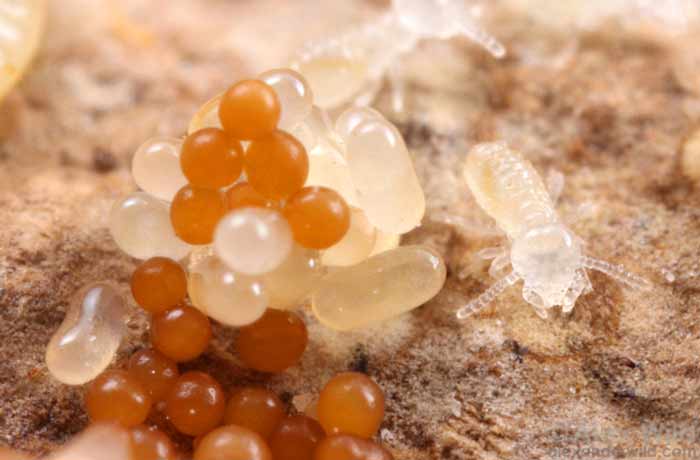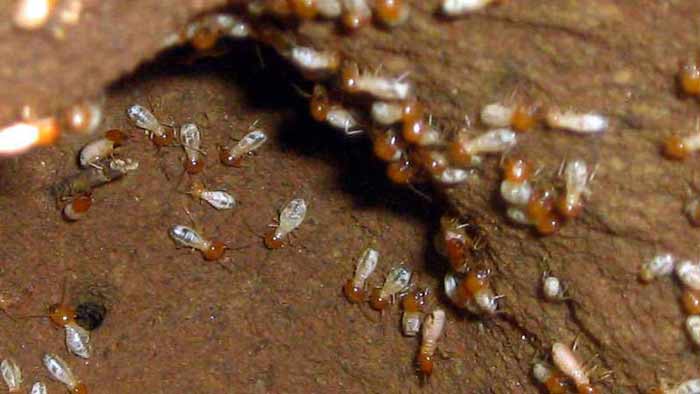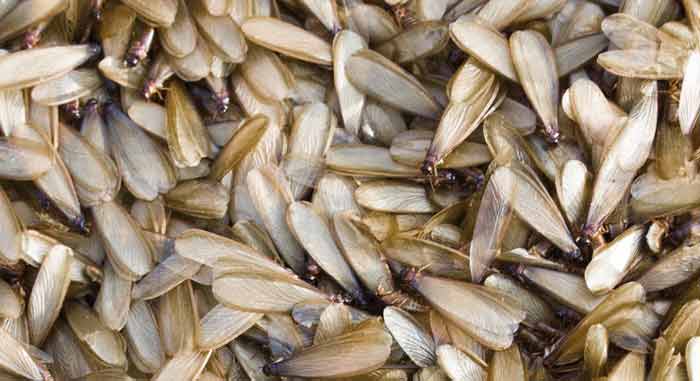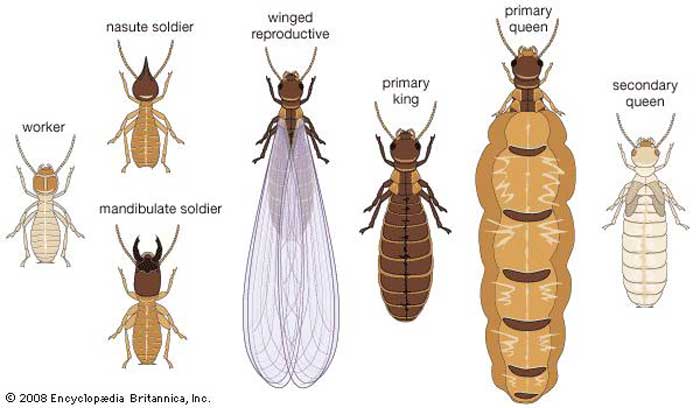Termites are among the few insects which undergo incomplete metamorphosis. This can be explained by its life cycle which consists of three stages; egg, larvae, and adult. This article discusses the cycle by shedding light on each of the three stages including the life span.
Table of Contents
Eggs
The life cycle of a termite starts with a fertilized egg. The egg of a termite is very small. It is white and has an oval shape.
The termite eggs can also be described as translucent or light brown in color.
The very first eggs laid by the queen termite are usually yellow in color no matter the termite species. Most of the eggs laid thereafter are white in color.
The size of termite eggs is found to be standard for most termite species. However, the very large termites may have slightly larger eggs. The best description given for the standard size of a termite egg is a full stop of font 14, verdana.
Although visible, you will rarely see those eggs since they are laid and kept well in the termite nest. For instance, the nest of subterranean termites is four to eighteen inches into the ground. Any other termite nests will be concealed inside structures.
The termite responsible for laying of eggs is the queen termite. For some huge termite colonies, however, there may be other reproductive termites that lay eggs. Such termites are referred to as secondary and tertiary reproductives.
Once the queen termite lays the eggs, the worker termite takes the eggs to incubation chambers. The eggs are usually kept next to the royal cell. This is where the eggs are taken care of until they hatch.
The incubation will take a few weeks before they hatch to larvae. An estimate of 26 days is given as the duration the termite eggs take before they can hatch.[1]
You can tell when the eggs are about to hatch since their size increases by about 30% from their normal size.
The duration taken before termite eggs hatch varies depending on the temperature surrounding the eggs.
There are a number of factors that may determine how many eggs a termite lays. They include age and the termite species.
A termite queen can produce up to 1000 eggs in a day. The maximum number of eggs that can be laid in a day is about 2000 eggs. The approximation of the number of eggs laid in the queen termite’s entire life is 9 million eggs. Such estimation may mean 30 colonies will be created by a single termite.
Larvae
Larvae refer to the newly hatched termites. They are usually as small as the termite eggs. Their bodies are usually soft and white in color. They are described as appearing like smaller versions of worker termites. This kind of appearance is because the termites are still immature.
The larvae survive on cellulose just like the adult termites. Even that, they need the worker termites to break the cellulose down for them. The larvae cannot break the cellulose down without assistance.
Before they are fully grown, the termites molt severally. This process goes on until the larvae develop to mature termites. Larvae cause damage indirectly.
Although they do not go to your wooden structures and burrow to find cellulose, they wait for the workers to do the destructive work and bring them food. If not protected and fed well, the termite larvae die.
If you wish to identify termite larvae, you will need to follow a few steps. The three simple and easy steps are;
- Firstly, examine the body of the insect. If the body feels soft and the antennae are straight originating from the head which is distinct from the rest of the body, then it is likely to be termite larvae.
- The next thing is to study their color. Termite larvae will be observed to be translucent or white in color.
- Lastly, you could take their measurement. Termite larvae are estimated to be 2.5mm long.[2]
Baby termites (Nymph)
Baby termites are very similar to ants especially because of their small size and their colored bodies. The baby termites or nymphs have the starting point of their life as the larval stage.
Baby termites have most if not all features of a normal termite. They have two antennae that are pointed and their waist is thick.
As soon as the nymph grows out of the larval stage, they begin to swarm. In most cases, it happens during the later days of spring. For the better part of their life, the nymphs retain the white color they had when they were babies.
Before the nymph can grow into an adult termite, it may take about a month. However, this stage may take a longer period in the case of temperate regions.
When the termite is at the nymph stage, it may molt seven times. In most cases, the adult worker termite helps the nymph shed its skin gradually as it approaches the adult stage.
The adult worker termite helps in the molting process by chewing off the skin of the nymphs. The soldier nymph however requires more molting compared to the worker.
The reproductives on the other hand take longer than the two castes; workers, and soldiers. They take several months before leaving the nymph stage and becoming adults.
Adults & Reproduction
An adult termite is one that has reached maturity point. It is through with its molting process. Mature termites are able to reproduce.
They also develop wings as well as functioning eyes. Termites at this stage can also be referred to as alates.
The bodies are darker and harder and this is why the termites are able to withstand less humid air and any exposure to light.
The adult stage is the one right after the nymphs. The adult termite may either be alate or winged termites as mentioned above and they could also be supplemental reproductive termites. The alates constitute the king and the queen.
The reproductives can also be classified as primary and secondary. The primary reproductives are the ones that are mature enough to begin the copulation process while the secondary reproductives are not ready yet for copulation. They wait to replace the primary reproductives.
The supplemental reproductives are described as the termites that offer back up to the king and the queen in growing the colony.
They are more common in the newly established colonies. Just like it is for alates, these reproductives stay in a part of the nest different from the ordinary termites.
The alates have the duty of starting new colonies. During the swarming season, adult termites are now referred to as swarming alates.
It is during this time that the mature alates fly away from their homes and land on a different place where they find a mating partner. It is not all the alates who leave their homes survive the process; only a few do.
After spotting a mating partner, the alates shed off their wings and start the mating process. If the pair of alates succeeds, they establish a new home and form a colony.
They become the king and the queen of such a colony. The queen lays eggs which later hatch and that way, the colony grows.
Life Span-how long do Termites live?
Termites can live for as short as 2 years and for as long as 50 years. Their colonies however can last for even more years. This difference in life span for different termites can be explained by a number of factors;
Position in the social order of the colony
The king and queen of termite colony are estimated to live longer than the rest of the termites. The queen lives longer than the king. She can live for decades as long as she is in a proper environment.
The workers and the soldiers live for only about one to two years. It is rare to find a queen surviving for 50 years. In the United States, she has been found to live for about 30 years.[3]
Temperatures
Termites living in warmer areas are likely to live longer than those in the cooler regions. This is because termites love warm and dark environments.
Although termites do not necessarily die during winter, they will have to burrow into the ground so that they can reach for a warmer environment.
Type of termite
No matter the type of termite, the workers and soldiers life span stays in a range of one to two years. The queen’s life span however will depend on the type of termite.
For instance, the subterranean termite queen lives for as long as 30 years while the drywood queen termite may only live for 10-12 years.
Exposure to termiticides
As soon as you realize that there are termites in your surroundings, you may opt for chemicals that will kill the termites.
Such treatment will definitely reduce the life span of the termites. Even though some termites may not die immediately, they will not live long before the chemicals overwhelm them.
Further Reading
- Termite Baits, Stations & DIY Traps
- Dampwood termites Pictures, Damage & Treatment
- Termite Tenting & Fumigation- Cost, Preparation, Safety & Cleaning After
- Termite Barriers (Shields): Types, Cost, how they Work & Products
- Termites Damage, Pictures, Repair Cost, Ceiling, Floors, Wood & Fix
- Best Termite Sprays-Orange Oil (DIY), Boric Acid & Spectracide Reviews
- Termites Life Cycle & Span-Eggs, Larvae, Baby & Adults
- How to Prevent Termites-Tips to Protect your Home
- Signs of Termites Infestation-How do you know if have you them?
- What do Termites look like? Pictures, Size, Color & Look-alikes
- Termites: Where From, Habitat, Eat, Noise, Types +more!
- Subterranean Termites Swarmers Treatment Cost, Damages & Pictures
- Flying Termites with Wings (Swarmers) Pictures & How to get Rid
- Termite Droppings-Drywood, what they look like, Health Risks, Clean vs Sawdust
- Formosan Termites Pictures, Signs Treatment & Damage
- How to Get Rid, Kill Termites + Treatment Cost
- What Causes & Attracts Termites?
- Do Termites Bite Humans? Pictures & Remedies
- Flying Ants vs Termites-Differences & Similarities
- Termite Inspection Cost, Procedure, how long it takes & Training
- Termite Colony-Queen, Soldier, Worker & King
- Drywood Termites Treatment Cost, Get rid & Damage
- Termite Bond Cost, Benefits
References
[1] https://www.termiteweb.com/termite-eggs/
[2] https://www.wikihow.com/Identify-Termite-Larvae
[3] https://www.terminix.com/blog/bug-facts/how-long-is-the-termite-lifespan




